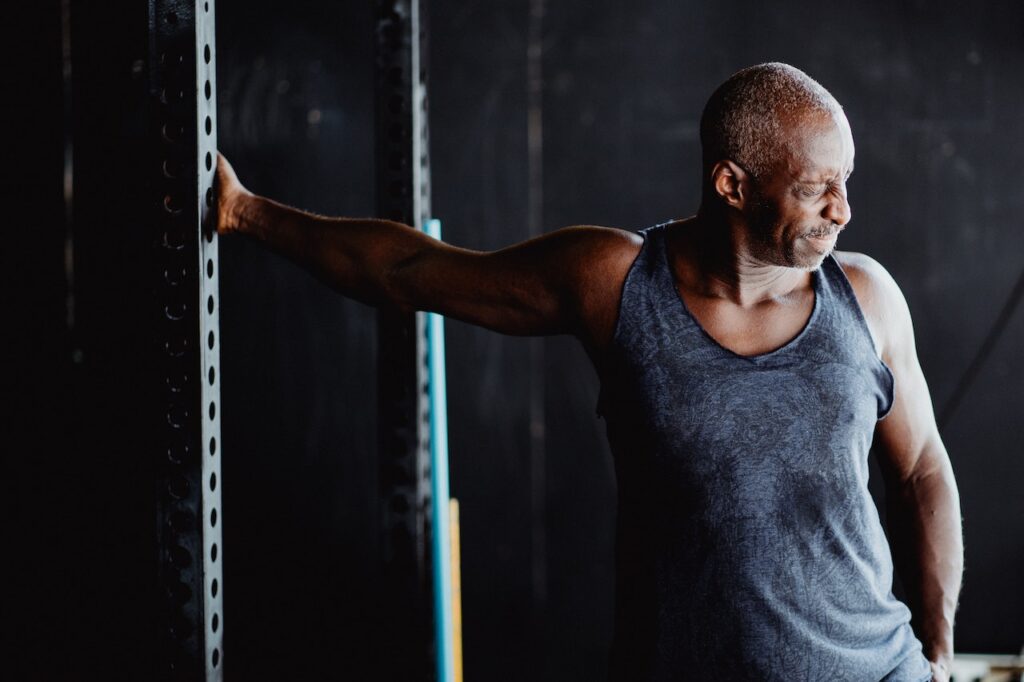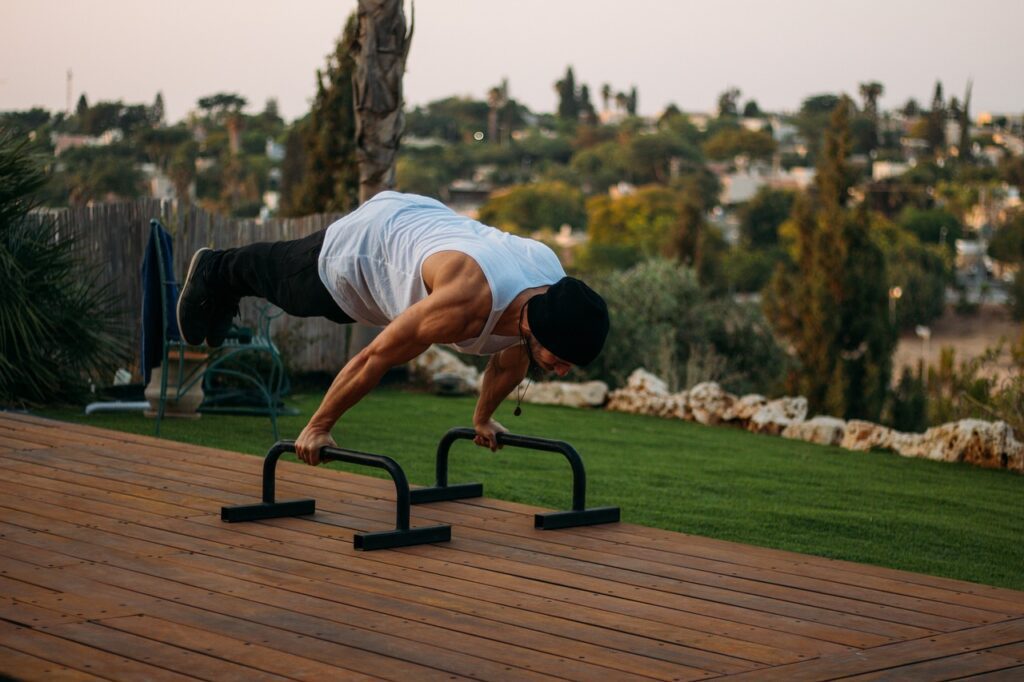What is Calisthenics?
Calisthenics is a workout approach that emphasizes using body weight for exercise rather than lifting weights. In this blog, we’ll delve into Calisthenics shoulder workout. If you are new to the world of Calisthenics, Read Our Calisthenics Beginner Guide.
Importance of shoulder strength and aesthetics
In the pursuit of a well-rounded and impressive physique, robust and visually captivating shoulders hold paramount importance. Not only do adequately developed shoulders augment your overall bodily structure, but they also contribute to improved posture, stability, and overall strength in the upper body.
Whether you identify as a zealous fitness enthusiast or a dedicated athlete, possessing sturdy and well-defined shoulders is crucial for optimizing performance and averting injuries.
Benefits of Calisthenics Shoulder Workout
Calisthenics, an exercise modality that leverages bodyweight movements, represents an outstanding approach to cultivating shoulder strength and size.
Diverging from conventional weightlifting practices, calisthenics exercises enable the activation of multiple muscle groups simultaneously, fostering functional and harmonious shoulder development.
By leveraging your body weight, you can challenge your shoulders in various planes of movement, enhancing stability and muscular endurance.
Moreover, calisthenics shoulder workout can be performed anywhere without the need for specialized equipment, making them accessible to everyone.
Understanding the Shoulder Muscles
A. Brief anatomy of the shoulder muscles:

To effectively target and train the shoulder muscles, it is important to possess a fundamental knowledge of their anatomical structure.
The shoulder joint, also known as the glenohumeral joint, is a ball-and-socket joint constituted by the humerus’s head and the scapula’s glenoid cavity. Important muscles within the shoulder are the following:
- Deltoids: The deltoid muscle comprises three distinct heads – anterior (frontal), medial (middle), and posterior (rear). It covers the shoulder joint and is responsible for shoulder abduction, flexion, and extension.
- Rotator Cuff Muscles: The rotator cuff, a collective assemblage of four muscles – supraspinatus, infraspinatus, teres minor, and subscapularis – functions harmoniously to stabilize the shoulder joint, effectuate arm rotation, and provide auxiliary support during various shoulder actions.
- Trapezius: Expansive in stature, the trapezius muscle stretches from the neck region to the upper back. It assumes the pivotal roles of stabilizing and retracting the scapulae, while also lending assistance to diverse shoulder movements.
4. Rhomboids: The rhomboid muscles, including the rhomboid major and rhomboid minor, lie between the shoulder blades and play a role in scapular retraction and stabilization.
B. Function and role of each muscle group:
Understanding the function of each shoulder muscle group is crucial for targeting them effectively during calisthenics shoulder workout:
1. Deltoids: The anterior deltoid assists in shoulder flexion and internal rotation, the medial deltoid is responsible for shoulder abduction, and the posterior deltoid contributes to shoulder extension and external rotation.
2. Rotator Cuff Muscles: The supraspinatus initiates shoulder abduction, the infraspinatus and teres minor assist in external rotation, while the subscapularis aids in internal rotation and stabilization.
3. Trapezius: The upper fibres elevate the scapulae, the middle fibres retract the scapulae, and the lower fibres depress and upwardly rotate the scapulae.
4. Rhomboids: The rhomboids retract and stabilize the scapulae, supporting proper posture and shoulder movement.
Common shoulder-related injuries and how to prevent them?

The shoulder joint is susceptible to various injuries, including rotator cuff tears, shoulder impingement, and labral tears. To prevent such injuries, it’s important to:
1. Warm up properly before workouts to increase blood flow and mobility.
2. Maintain proper form and technique during exercises, avoiding excessive strain on the shoulders.
3. Gradually progress the intensity and volume of shoulder exercises to avoid overuse injuries.
4. Incorporate exercises that strengthen the rotator cuff muscles to enhance shoulder stability.
5. Ensure adequate rest and recovery between workouts to allow the shoulder muscles to repair and regenerate.
By understanding the shoulder anatomy, function, and common injuries, you can effectively target the shoulder muscles during your calisthenics shoulder workouts while minimizing the risk of injury.
Warm-Up Routine for Calisthenics Shoulder Workout.
A. Importance of warming up before any workout:
Before diving into your calisthenics shoulder workout, it is crucial to prioritize a proper warm-up routine. Warming up serves several essential purposes, including:
1. Increasing blood flow: Doing light aerobic exercises raises your heart rate and increases blood circulation, delivering oxygen and nutrients to the working muscles.
2. Enhancing joint mobility: Dynamic movements before a workout helps lubricates the joints, increasing their range of motion and reducing the risk of injury during the workout.
3. Activating the nervous system: A warm-up stimulates the nervous system, preparing your muscles for upcoming exercises and improving coordination.
4. Mentally preparing for the workout: Warming up also helps shift your focus to the training session ahead, allowing you to mentally prepare and optimize performance.
B. Dynamic stretching exercises for the shoulder joints:

Incorporating dynamic stretching exercises into your warm-up routine helps loosen up the shoulder joints and surrounding muscles. Here are a few dynamic stretching exercises to consider:
1. Arm Circles: Stand with your feet shoulder-width apart. Extend your arms straight out to the sides, parallel to the ground. Make small circles with your arms, gradually increasing the size of the circles. Reverse the direction after a few repetitions.
2. Shoulder Rotations: Stand tall and bring your arms forward, crossing them at the wrists. Slowly rotate your arms outward and upward in a circular motion, then bring them back down and inward. Repeat this movement for several repetitions.
3. Scapular Push-Ups: Assume a high plank position with your hands slightly wider than shoulder-width apart. Keeping your arms straight, squeeze your shoulder blades together, and then push your shoulder blades apart. Perform this movement in a controlled and fluid motion.
C. Shoulder mobility drills to activate the muscles:
Shoulder mobility drills are designed to activate and prepare the muscles for the upcoming workout. Consider incorporating the following drills into your warm-up routine:
1. Shoulder Dislocations: Hold a broomstick, towel, or resistance band with a wide grip. Begin with the stick in front of your thighs, then raise it overhead and behind your body, aiming to touch your glutes. Reverse the movement and return to the starting position. Perform several repetitions in a slow and controlled manner.
2. Wall Slides: Stand with your back against a wall and your feet about 6 inches away from the wall. Place your elbows and forearms against the wall at a 90-degree angle. Slide your arms upward, keeping your forearms and elbows in contact with the wall. Slowly return to the starting position. Repeat for multiple reps.
3. Arm Swings: Stand with your feet hip-width apart. Extend your arms straight out to the sides. Swing your arms forward, crossing them in front of your body. Then, swing them backwards, crossing them behind your body. Continue this swinging motion for several repetitions.
Calisthenics Shoulder Workout
People Also Read: Calisthenics Push Workout
A. Push-Up Variations:
1. Standard Push-Ups: Assume a high plank position with your hands slightly wider than shoulder-width apart. Lower your chest towards the ground while maintaining a straight line from your head to your heels. Push back up to the starting position.
2. Wide Push-Ups: Perform standard push-ups, but place your hands wider than shoulder-width apart. This variation targets the chest and shoulders from a wider angle.
3. Pike Push-Ups: Start in a downward dog position, with your hips raised and hands shoulder-width apart. Lower your head towards the ground by bending your elbows while maintaining a straight line from your head to your tailbone. Push back up to the starting position.
B. Handstand Push-Up Progressions:
1. Wall-Assisted Handstand Push-Ups:
Begin facing a wall in a handstand position with your hands placed slightly wider than shoulder-width apart. Lower your body towards the ground by bending your elbows, then push back up to the starting position. Use the wall for balance and support.
2. Pike Press Handstand Push-Ups:
From a pike position with your hips raised, bend your elbows and lower your head towards the ground. Push back up to the starting position. This variation places more emphasis on the shoulders.
3. Freestanding Handstand Push-Ups:
Once you have built sufficient strength and balance, attempt handstand push-ups without the support of a wall. Perform the movement by lowering your head towards the ground and pushing back up while maintaining stability.
C. Dips and Dip Variations:
1. Parallel Bar Dips: Place your hands on parallel bars with your body suspended. Lower yourself by bending your elbows, then push back up to the starting position. This exercise targets the shoulders, chest, and triceps.
2. Ring Dips: Use gymnastic rings or suspension straps for this variation. Hold onto the rings with your arms extended and perform dips by lowering your body, bending your elbows, and pushing back up. Ring dips engage stabilizer muscles to a greater extent.
3. L-Sit Dips: Perform parallel bar dips, but extend your legs straight out in front of you in an L-shape. This variation adds an additional challenge to the shoulders, core, and hip flexors.
D. Shoulder Taps and Plank Variations:
1. Shoulder Taps in High Plank Position: Start in a high plank position with your wrists directly under your shoulders. Lift one hand off the ground and tap the opposite shoulder, then alternate sides. Maintain a stable core and avoid rotating your hips.
2. Side Plank Variations: Assume a side plank position with your elbow under your shoulder and feet stacked or staggered. Lift your top arm towards the ceiling, then lower it back down. This exercise engages the shoulder muscles and promotes stability.
E. Inverted Rows:
1. Bodyweight Rows: Set up a bar at waist height or use gymnastic rings. Lie under the bar, grasp it with an overhand grip, and position your body at an angle. Pull your chest towards the bar while keeping your body straight, then lower yourself back down.
2. Archer Rows: Perform bodyweight rows, but during the pulling motion, rotate your body to one side, extending one arm straight out to the side. This variation targets the shoulder muscles asymmetrically.
3. Wide Grip Inverted Rows: Position your hands wider than shoulder-width apart on the bar or rings. Perform inverted rows by pulling your chest towards the bar while keeping your body straight. This variation emphasizes the outer shoulder muscles.
Training Program
A. Beginner’s routine for shoulder strength:
1. Sample workout schedule:
– Day 1: Push-Up Variations and Shoulder Taps
– Day 2: Rest
– Day 3: Handstand Push-Up Progressions and Plank Variations
– Day 4: Rest
– Day 5: Dips and Inverted Rows
– Day 6-7: Rest
2. Recommended sets and reps:
– Perform 2-3 sets of each exercise.
– Aim for 8-12 repetitions per set, focusing on maintaining proper form.
– Take a 60-90 second rest between sets.
B. Intermediate/Advanced routine for shoulder hypertrophy:
1. Progressive overload techniques:
– Increase resistance: Use weighted vests, backpacks, or resistance bands to add external resistance to your exercises.
– Increase range of motion: Incorporate deeper ranges of motion, such as deficit handstand push-ups or dips, to challenge your muscles further.
– Decrease leverage: Gradually progress towards more challenging variations, such as freestanding handstand push-ups or ring dips.
2. Incorporating supersets or circuits:
– Supersets: Pair two exercises targeting different muscle groups, such as push-ups and inverted rows, and perform them back-to-back with minimal rest.
– Circuits: Combine multiple exercises targeting the shoulders and other muscle groups into a circuit. Complete one set of each exercise before resting and repeating the circuit.
C. Tips for proper form and technique:
1. Maintain proper alignment: Keep your shoulders down and back, engage your core, and avoid overarching or rounding your back.
2. Control the movement: Perform exercises in a slow and controlled manner, focusing on the mind-muscle connection and feeling the tension in the shoulder muscles.
3. Avoid excessive shoulder elevation: During exercises like push-ups and dips, avoid shrugging your shoulders towards your ears. Keep them stable and engaged.
4. Gradually progress: Start with the appropriate difficulty level for your fitness level and gradually increase intensity, resistance, or difficulty as you become stronger and more proficient in the exercises.
5. Listen to your body: Pay attention to any discomfort or pain in your shoulders. If you experience any unusual pain or discomfort, modify the exercise or seek guidance from a fitness professional or healthcare provider.
Injury Prevention and Recovery
A. Importance of rest and recovery days:
Rest and recovery are essential components of any training program, especially when it comes to shoulder health. Here’s why rest days are crucial:
1. Muscle repair and growth: Rest days allow your muscles, including the shoulder muscles, to recover from the stress of training, repair damaged tissues, and grow stronger.
2. Injury prevention: Overtraining and insufficient rest can lead to overuse injuries, including shoulder-related issues like tendinitis or impingement. Adequate rest helps prevent these injuries and promotes overall joint health.
3. Mental and emotional well-being: Rest days provide an opportunity for mental and emotional recovery, reducing stress levels associated with intense training and promoting a balanced approach to fitness.
B. Tips for avoiding shoulder injuries:
To minimize the risk of shoulder injuries, follow these important tips:
1. Warm-up properly: Always begin your workouts with a thorough warm-up routine, including dynamic stretches and mobility exercises specifically targeting the shoulders.
2. Use proper form and technique: Focus on maintaining proper alignment and technique during exercises, especially those that place stress on the shoulders. Avoid excessive weights or movements that cause pain or discomfort.
3. Gradually increase intensity: Progressively increase the intensity and difficulty of your shoulder workouts over time. Avoid sudden spikes in training volume or load, as this can increase the risk of injury.
4. Listen to your body: Pay attention to any signs of discomfort, pain, or fatigue in your shoulders. If you experience persistent pain or discomfort, modify or cease the exercise and consult with a healthcare professional.
5. Balance pushing and pulling exercises: Ensure a balanced training program that includes both pushing and pulling exercises to avoid muscle imbalances that can contribute to shoulder injuries.
C. Rehabilitation exercises for common shoulder issues:
If you’re dealing with a specific shoulder issue or injury, consider incorporating these rehabilitation exercises after consulting with a healthcare professional:
1. External Rotation with Resistance Band:
Attach a resistance band to a stationary object at waist height. Hold the band in one hand and step away, creating tension. Keep your elbow bent at a 90-degree angle and rotate your forearm away from your body against the resistance of the band. Repeat on both sides to strengthen the rotator cuff muscles.
2. Wall Slides:
Stand with your back against a wall and your arms against the wall in a “goalpost” position, with elbows bent at 90 degrees. Slide your arms up and down the wall while maintaining contact with the wall. This exercise helps improve shoulder mobility and stability.
3. Scapular Retraction:
Lie face down on a mat with your arms extended straight out in front of you. Squeeze your shoulder blades together, lifting your arms off the ground. Lower them back down. This exercise helps strengthen the muscles responsible for scapular retraction and stabilization.
It’s important to remember that rehabilitation exercises should be tailored to your specific condition and prescribed by a healthcare professional or physical therapist. Follow their guidance and gradually progress the intensity of the exercises as you regain strength and mobility.
Conclusion:
In conclusion, developing strong and healthy shoulders is vital for both functional strength and aesthetic appeal. Calisthenics offers a range of effective exercises to target the shoulder muscles without the need for equipment.
Understanding the anatomy of the shoulder, preventing injuries through proper warm-up and technique, and incorporating a well-rounded training program is essential. Rest and recovery days should not be overlooked, as they allow for muscle repair and injury prevention.
By following these guidelines and seeking professional advice when needed, you can achieve impressive shoulder strength and maintain optimal shoulder health in your calisthenics journey. Calisthenics Shoulder workout can be game-changing for your shoulder health.
Remember, consistency and patience are key to reaching your fitness goals while keeping your shoulders safe and strong. Give Calisthenics Shoulder Workout a Go.
I hope you liked this blog post Titled” Calisthenics Shoulder Workout for Beginners”
Hello, fellow fitness enthusiasts! I'm Zayn, a Board Certified Fitness and Nutrition Coach. My journey started from a personal commitment to fitness, and over time, this passion ignited a desire to help others unlock their potential. I transformed this passion into my profession, and today, I'm proud to say that I am armed with a plethora of certifications, all testament to my dedication and commitment.
When I'm not advising clients or working on my next blog post, you'll find me trying out new fitness regimes, diving into the latest nutritional research, or practicing what I preach with my own healthy lifestyle. My mission is to help you become the best version of yourself, showing that fitness and nutrition are as much about the journey as they are about the destination.


